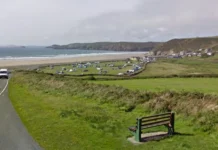The comment I hear the most from people when I mention that I’m looking into my family history and doing my family tree is “I wouldn’t know where to start.”
I thought that I’d take a break from advising Debbie Hibbard Williams on how to look into her Great grandmother’s life and try and pass on the tips I’ve found that makes researching family history a little bit easier.
As I mentioned in my first Family Ties article, I made my first serious effort into researching my family tree back in 1991. This of course was before the Internet became so widely used. I didn’t have the Internet, or even a home computer, so I went about it the way every family historian and every family history site recommends.
I questioned my relatives, mostly my parents and my Auntie May, who were great sources of information. Always write down whatever information you get and note down who gave you the information and when. It’s always useful to have this available.
By comparing notes given from different sources you are able to build up a base for your first step, usually your grandparents, on your tree. The next step is to collect, copy or just note information down from any relevant certificates you can get your hands on. It’s expensive having to buy certificates to get information to further your research, so all the better if you can have access to any certificates various family members may have lying around the house, without even realising that they have them, especially at the earlier stages.
My husband had three marriage certificates in a box with some old photos for years, passed on from his mother. They were certificates of marriage for his parents, grandparents and great grandparents!
Some people may be reluctant to give you their certificates for your research. To get around this problem without having to buy the certificate, either arrange to borrow the certificate and make a photocopy or just note down all the information given on the certificate.
Once you’ve been bitten by the family history bug, you’ll find that the more research you do, the more clues you’ll uncover. Once you find a clue to advance your research, you’ll just have to follow it through! This is where it’s important to keep records of all the things that you find and your sources, where you found the information. It could be in your great aunt’s family bible, or it could be from the Parish Records kept at the County Records Office. Wherever you found your information, make a note of it!
Some people prefer to have the old style filing system, with files and folders. Some prefer to keep all of their records stored on a computer. I think most people work with a combination of both systems. I know I do. Personally, I find that this way works best, so it’s really up to the individuals own preference. There is no hard and fast rule that says a particular system is the right one to use.
Here are some hints and tips from the Help and Advice Centre at www.ancestry.co.uk.
Some points to remember are:
Talk to your older relatives
The key point here is to ask sooner rather than later. Many of us only get interested in family history as we get older, so sadly the opportunity to ask older relatives can have disappeared. Older relatives can push your family research back two or three generations which will give you a firm standing point for your work. But don’t despair if you don’t have anyone older to ask: siblings and cousins may know some details which haven’t yet been passed on to you.
In my own experience, I would have found it more difficult to compile my tree in 2008 without the information given to me by my father when I started my search in 1991. By 2008, my father had sadly passed away, but I built the tree on the information he had given me.
Reluctance to provide information
While most of your family may be happy to talk to you about family history, you may find that some people might be a bit more reluctant. Older relatives might not initially want to talk about things such as a child being born before the marriage of the parents. If you can, try to patiently explain why you want to talk about the family and how any information could really help. You could promise to share your findings too, as this could in turn make them curious about the wider family.
In my own family, there have been instances of children born out of wedlock or after the parents had been married only a few months. On each occasion, especially with older relatives, they are reluctant to discuss the circumstances, due to the stigma attached to being either an unmarried mother or having a “shotgun wedding”.
Preparation of questions
Having questions prepared beforehand is a good idea, but you don’t need to stick to them like a script. You might feel nervous talking to a relative you hardly know, or have never met before, during your research. They might feel nervous too. Keep it informal and friendly and at the end ask them if it’s OK to visit them again or call back later for another chat.
Over the past few years, since starting my search, I’ve found myself speaking to relatives that I didn’t even know existed. It adds to a stressful situation if you have a list of question to stick to. I try and jot notes down about facts or people I’m interested in as well as some questions, rather than a long list of just questions. It need only be a few words or dates to jog your memory.
Types of questions to ask
Try to keep your questions open, rather than direct and the discussion will flow better. “What was your grandfather’s name?” might get a very short answer. But if you say, “I’m really interested in your grandfather, what do you remember about him?” make your relative feel valued. With dates, it’s a good idea to give a reference point, such as: “Was it before the war that he was born?” And old photographs can be a very useful aid: “Is this your mother at the house in Felinfoel?” may bring up entirely unknown details.
And don’t forget to ask about the life of your relative too. How they lived and what they did will add depth to your research, help you imagine their lives, and will be fascinating for future generations.
The more background information you can get the better! It helps to build a better “bigger picture”. Sometimes the information you get from the person will seem trivial, but it all helps. I knew that my grandmother had attended Dafen Primary School as a child, but I assumed it was the building in the same place as modern day Dafen School. Fortunately, when I interviewed another elderly relative who attended the school, I found out that at the time my grandmother was a pupil there, the school was in a completely different area of Dafen altogether!
Find the family records
During your chat, it might also be worth trying to find out if your relative has any family records and documents they wouldn’t mind sharing with you. If they don’t have them, you might discover who has them, at least. The same is true of photographs, which may have been passed down a different family line.
You tend to find in families that certain types of photos or photos or documents from a particular place or time are passed through one branch of the family. In my own family, my father was the only one of his siblings to go and live and work at his grandparents’ farm. As a result, my father was the only one in his family who had photos taken at the farm, doing things like riding a tractor or herding cows. Also, as he lived there with his grandparents as a teenager and young man, he also had photos of his
grandparents at the farm, which are a great legacy to the younger generations in the family.
True or false?
Unwittingly, not all the information you’re given may be correct – but nevertheless, you now have a great starting point to begin your research. The trick is to always check the accuracy of your information against other sources. Family stories can get embellished, and memories can fade over time, so it’s really important to check the facts as much as possible. As you gather more information from other relatives, you can add your notes and stories to your Family Tree.
One set of my great, great grandparents had a farm in Pembrokeshire called, much to our amusement, Stark Naked Farm, or so we thought. My father originally mentioned this farm when I was a child and as a teenager, I went with my parents to find it, as my father remembered going there as a young boy. We found it, but it was a private house, no longer a farm and had been renamed.
I can’t think why! When I checked the Census records for the mid to late 1800’s back in 2008, I found out that the name of the farm was actually Start Naked. I don’t know if my father misheard the name originally. I’ve since been in contact with relatives, also descendants of my great, great grandparents and some of them had also been told that it was called Stark Naked Farm!
Jumping to conclusions
Genealogy is all about proof. Start your research with yourself and work backwards, one generation at a time. The key to success is to prove conclusively the link between the generations, and you can only reach a conclusion if you have enough evidence. Reaching a conclusion based upon incomplete evidence can throw your whole tree out.
If you’re not sure about a connection, make a note of your theory first, and then try to prove that theory – but don’t assume it as fact! Whenever you find a record that possibly matches a person you are looking for, make a note of it and where you found the information, so that you can go back to it once you have exhausted all other possible matches.
The challenge in proving the link between the generations is increased when dealing with common names. I had documents on a family I believed to be my great, great grandmother and her parents and siblings, but their surname was Smith and their first names were all common names in the 1800’s, i.e. John, William, Elizabeth, Mary.
As I couldn’t prove it was them, I left the documents pending for nearly 2 years. Finally, the 1911 Census became available and I found my great, great grandparents on it. For her place of birth, she had not only put the Pembrokeshire village down, but, helpfully, she’d also included the name of the farm she had been born and brought up in. I thought that the name seemed familiar and on checking the old Census records for the Smith family that I had kept aside, I found that the names of the farms matched.
Document your sources
The biggest mistake you can ever make is not documenting where you found your information. Remember that your research is only part of a much larger body of information. We owe it to future generations to be accurate so that we don’t set off a chain of events that could mean someone out there is jumping to conclusions or researching the wrong family entirely. See your research as your heritage, and your story!
This is a mistake that I know only too well! When I started looking up family history documents on the internet in 2008, I was so excited and overwhelmed to find documents such as Census Records and Parish Records online that I forgot to note down in my written records where I had found them. Seeing as I was using about four or five different sites to get my information, this became a problem after a while. I had to go back and look up each document again and make a note of the website. I didn’t have a working printer, so I was visiting the sites and taking notes. If I’d remembered the first time to make a note of which website the various pieces of information came from, I would have saved myself some work!
Assuming a family name is only spelt one way
Family names can be spelt in a number of different ways as our ancestors (and the people who recorded their events) could be very unreliable! Smith can be Smyth, Morgan can be Morgans and Harries can be Harris. Make sure you check all the phonetic variations of your name just in case – although this is time-consuming the results could make it all worthwhile.
One of the first people I looked up in my research into my own family history was my great grandfather Thomas Henry Morgan. I wasted months looking for him and narrowing it down to three men, born in the same area and of similar age, but known as Thomas Morgan. A chance remark by an elderly relative made me widen the search to include the surname Morgans and there he was, the first one on the page, Thomas Henry Morgans.
Skipping a generation
In lots of families, it’s common to have the same name running through three or more generations of male ancestors. This can easily trip you up if you’re not methodical, leading you to list someone as the father when he is the grandfather. Record as many dates as possible and carefully evaluate things like place names and occupations to avoid this happening.
In one branch of my family tree, the name Benjamin is passed down the generations, from father to son. Needless to say, they all lived in the same village. The only way to keep track of them was to keep a close eye on their years of birth and to make a note of their occupations, which even though they were similar, such as farmer, agricultural labourer or even shepherd, are totally different occupations.
Help keep news FREE for our readers
Supporting your local community newspaper/online news outlet is crucial now more than ever. If you believe in independent journalism, then consider making a valuable contribution by making a one-time or monthly donation. We operate in rural areas where providing unbiased news can be challenging. Read More About Supporting The West Wales Chronicle






















